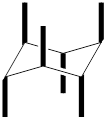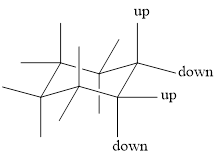
Concept explainers
Interpretation:
The most stable chair conformation for the given compound has to be drawn.
Concept Introduction:
When a compound contains a cyclohexane ring in it, then there are three possibilities of conformations. They are chair, boat and twist-boat. Among these three conformations of cyclohexane ring, the most stable one is the chair conformation.

In the above structure, there are twelve substituents that can be placed. Among the twelve, six are axial substituents and six are equatorial substituents. The axial substituents can be represented as shown below,

The equatorial substituents can be represented as,

To draw a group in a correct configuration, we have to understand what is coming towards us and what is going away from us (wedge and dash bonds).

For drawing the other chair conformation, a ring flip has to be done. Ring flipping makes the skeleton as shown below,

During this ring flip from one chair conformation to another, all the substituents present in axial position goes to equatorial position and vice-versa.

The most stable conformation among the two chair conformations can be found by looking into the bulky groups that are present in the ring. The chair conformation which has the bulky group in equatorial position will be the more stable one as there wont be steric interaction. If the bulky group is present in axial position, then there will be axial-axial interaction, which makes the conformation less stable. In simple words, we can say that the bulky group will prefer to be in equatorial position.
Want to see the full answer?
Check out a sample textbook solution
Chapter 6 Solutions
ORGANIC CHEMISTRY-NEXTGEN+BOX (1 SEM.)
- Provide the unknown for the given data.arrow_forwardElectron Arrangement A. Fill in the following chart relating to levels, sublevels and orbitals. Levels (n) 1 Sublevels # of Orbitals per sublevel 2 3 4 # of Electrons per sublevel Total Electrons per level Complete: B. Answer the following questions related to levels, sublevels, orbitals and electrons. 1. How many sublevels are in energy level 2? 2. How many orbitals are in a 4f sublevel? 3. How many electrons can level 3 hold? 4. How many orbitals are in level 4? 5. How many electrons can sublevel 2p hold? 11arrow_forwardProvide the unknown for the given details.arrow_forward
- Part II. For the following compounds predict the no. Of signals expected for the 9) c) b d) C-NMR spectrum: لكمarrow_forwardIdentify the S and R configuration of all chiral centers.arrow_forward1) Draw the control charts for the following data and interpret the result and also develop control limts for future use. 24 samples are taken each with a subgroup size of 3. Don't Use the standard excel template and analyze.arrow_forward
- 1) Draw the control charts for the following data and interpret the result and also develop control limts for future use. 24 samples are taken each with a subgroup size of 3. Problem to be solved both as an assignment and laboratory. Subgroup X₁ X2 X3 1 7 8 10 2 9 9 14 3 15 16 10 4 14 13 15 5 12 11 10 6 10 11 9 I 7 10 9 9 8 15 17 13 9 10 7 8 10 9 8 9 11 8 8 10 12 17 13 10 13 10 12 11 14 9 9 10 15 10 8 8 16 11 10 9 17 10 10 8 18 8 9 7 19 9 8 9 22222 10 10 11 9 10 9 11 9 10 12 12 11 14 2012 4arrow_forwardHow much of each solution should be used to prepare 1L of a buffer solution with a pH of 9.45 using 3M Na2CO3 and 0.2M HCI? Given: Ka 1 = 4.3 × 10-7, Ka2 = 4.69 × 10-11arrow_forwardAdd substituents to draw the conformer below (sighting down the indicated bond), then rotate the back carbon to provide the anti staggered conformer. + H3C H Ph H Problem 25 of 30 Drawing Atoms, Bonds and Rings Charges Tap a node to see suggestions H H H Undo Rasat Remove Done Finish update Rotate Submitarrow_forward
 ChemistryChemistryISBN:9781305957404Author:Steven S. Zumdahl, Susan A. Zumdahl, Donald J. DeCostePublisher:Cengage Learning
ChemistryChemistryISBN:9781305957404Author:Steven S. Zumdahl, Susan A. Zumdahl, Donald J. DeCostePublisher:Cengage Learning ChemistryChemistryISBN:9781259911156Author:Raymond Chang Dr., Jason Overby ProfessorPublisher:McGraw-Hill Education
ChemistryChemistryISBN:9781259911156Author:Raymond Chang Dr., Jason Overby ProfessorPublisher:McGraw-Hill Education Principles of Instrumental AnalysisChemistryISBN:9781305577213Author:Douglas A. Skoog, F. James Holler, Stanley R. CrouchPublisher:Cengage Learning
Principles of Instrumental AnalysisChemistryISBN:9781305577213Author:Douglas A. Skoog, F. James Holler, Stanley R. CrouchPublisher:Cengage Learning Organic ChemistryChemistryISBN:9780078021558Author:Janice Gorzynski Smith Dr.Publisher:McGraw-Hill Education
Organic ChemistryChemistryISBN:9780078021558Author:Janice Gorzynski Smith Dr.Publisher:McGraw-Hill Education Chemistry: Principles and ReactionsChemistryISBN:9781305079373Author:William L. Masterton, Cecile N. HurleyPublisher:Cengage Learning
Chemistry: Principles and ReactionsChemistryISBN:9781305079373Author:William L. Masterton, Cecile N. HurleyPublisher:Cengage Learning Elementary Principles of Chemical Processes, Bind...ChemistryISBN:9781118431221Author:Richard M. Felder, Ronald W. Rousseau, Lisa G. BullardPublisher:WILEY
Elementary Principles of Chemical Processes, Bind...ChemistryISBN:9781118431221Author:Richard M. Felder, Ronald W. Rousseau, Lisa G. BullardPublisher:WILEY





